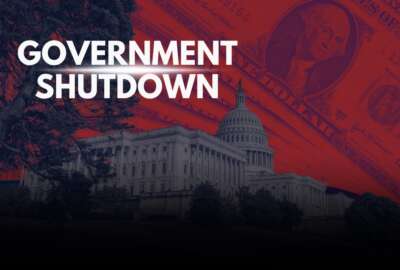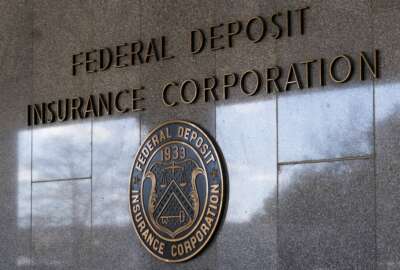Forget strategic planning. What you need is a little strategic foresight
"Using strategic foresight will absolutely help organizations become more resilient," said Robin Champ.
How many strategic planning meetings have you sat through for strategies that never panned out. Maybe it’s because your organization tried to predict the future. Maybe you should try strategic foresight. It’s not forecasting, but rather an organized way of anticipating the future. Both the General Services Administration and the Office of Personnel Management have online material about strategic foresight. Now an organization devoted to it has called for a federal office of strategic foresight. The Federal Foresight Advocacy Alliance, vice president Robin Champ joined the Federal Drive with Tom Temin to discuss more.
Interview transcript:
Tom Temin And we should begin with the fact that you practiced strategic foresight for many years as a federal employee. Tell us about that.
Robin Champ Yes, I worked for the last 20 years in government, both at the Department of Defense and the U.S. Secret Service leading strategy and foresight for a couple of organizations. I retired last year, and I am now doing consulting and teaching in the private industry. But I met up with two amazing women, Suzette Brooks Masters and Kara Cunzemen. And the three of us decided we are really going to champion the use of strategic foresight in the federal government to improve our strategy. So the three of us co-founded and co-chaired the Federal Foresight Advocacy Alliance.
Tom Temin We’ll get into the alliance, but let’s begin maybe with a definition of strategic foresight.
Robin Champ Absolutely. So strategic foresight is about planning for uncertainty. So with this, we accept that the future is uncertain. We accept that there are disruptions. We accept that we can be caught by surprise, and we want to prepare for this future. And usually we do this by looking at signals and trends in the environment, by exploring multiple different scenarios via scenario based planning, and looking at the fact that we need to be prepared for whatever might come our way, not just trying to go down one particular path.
Tom Temin It sounds like it’s related to that resilience idea.
Robin Champ Absolutely. Using strategic foresight will absolutely help organizations become more resilient. And that is the key benefit of practicing strategic foresight.
Tom Temin It sounds like then that you don’t try to forecast what will happen and plan for that, which was what usually happens in strategic planning. But being able to be light on your feet so that you have a strategy for whatever happens.
Robin Champ Exactly. In fact, many people confuse the terms forecasting and foresight. They might use them interchangeably when they’re two completely different things. So like you said, with forecasting, we’re predicting something, and it’s usually really good in the short term. So for instance, before I came here today, I looked at the weather, and I could be fairly certain with the weather forecast, the weather prediction that it was going to be sunny in the 70s and it wasn’t going to rain. But if I look forward six months, let’s say, in May, you can’t say with any certainty, is it going to be raining out, sunny out, warm out. But I still need to have a closet with an umbrella and sunglasses and everything so that I’m prepared, so when the time gets closer, I can use my forecast, when it can be an accurate prediction.
Tom Temin Right. So keeping a basketball and an umbrella in your car is strategic foresight.
Robin Champ Absolutely.
Tom Temin And how does it work in a corporate or federal agency setting? What do you do to make strategic foresight?
Robin Champ Absolutely. So a lot of organizations use scenario based planning. In fact, Shell Oil Company has been doing scenario planning for the last 50 years. And it was their work in the 1970s that helped them fare much better than their competitors during the 1973 oil crisis. Because they took time to work through these scenarios, even if they were unlikely. And because of that, because they thought through these things, because they were able to unleash some creativity, they were better able to prepare for the uncertain future.
Tom Temin Abraham Lincoln said, my only plan is to not have a plan. Do you think that agencies and large organizations do too much planning and not enough foresight, and therefore they find themselves, Whoops, I went here, but the reality went there.
Robin Champ Yeah. There’s pockets of foresight excellence in the US government. In fact, there’s another group called the Federal Foresight Community of Interest, where many government folks come together to try to share best practices. But it’s definitely hit and miss in the government, and there are many strategic plans that are written without looking in the future at all, without doing any scenario planning, without looking at the emerging signals of change. And really, that’s why we co-founded the FFAA to try to ensure that strategic foresight is practiced before our strategists sit down and write a strategic plan in the U.S. government.
Tom Temin We’re speaking with Robin Champ. She’s a co-founder of the Federal Foresight Advocacy Alliance. And there is guidance, as we mentioned at the top, even from Circular A-11, which covers just about everything.
Robin Champ Yes. So OMB Circular A-11 is the implementing instruction for the Government Performance and Results Act Modernization Act (GPRA). And this guidance tells federal employees how to do strategic planning. And about six years ago, OMB Circular A-11 was modified to include strategic foresight, specifically as a best practice and encouraging agencies to use strategic foresight before they sit down to write their strategic plans.
Tom Temin All right. So it sounds like something that should be part of budget planning, for that matter.
Robin Champ Absolutely. We should have very robust strategies before we write our budgets. In fact, the other thing that we are championing is formal training, both in foresight and in strategic planning, before we have folks sit down and write a strategic plan.
Tom Temin So, for example, if I was the Environmental Protection Agency, and we’re not taking sides here, but a good strategic foresight would say, here’s what our budget and our plans look like if the Kamala Harris wins the election. Here’s what it looks like if Donald Trump should win the election. That way, at least they’re better prepared than putting their bets on one horse or the other.
Robin Champ Absolutely. During our scenario based planning, we try to look at the most impactful and uncertain drivers of change, and use those to help frame the scenarios.
Tom Temin So then it sounds like the talent here or the skill is making sure that all of the possibilities get inculcated into the foresight exercise. That is to say, I’m just making the absurd example to continue with the EPA. We should plan for the discovery that burning coal actually reduces carbon gas. That’s not going to happen. But sometimes out of the blue, discoveries change basic assumptions. You have to have your mind open wide enough for all those possibilities.
Robin Champ Absolutely. You have to have a very open mind. We have to look at many possibilities, even the ones that are unlikely or we think are improbable. We have to consider them when doing our scenario planning.
Tom Temin All right. And the alliance itself is advocating for an Office of Strategic foresight.
Robin Champ Yes, we are. We are hoping it will be in OMB to help make that direct link between strategic foresight and strategic planning. So we think OMB would be a great place for it to sit. There are other options we’ve been discussing, so we’re not opposed to some other options, just talking to many people in the federal government. We do think OMB would be a great place for it. We are also calling for a position called the chief Foresight officer, who would be dual hatted as the chief strategy officer. So in order not to create yet more positions in the government, we just want to make sure that these chief strategy officers are including foresight in their work. So we want that position to be dual hatted.
Tom Temin I was going to say every chief XO should be the one to kind of impose strategic foresight on his or her planning processes.
Robin Champ Absolutely.
Tom Temin And well, I guess my question is, what do you need to learn to be able to do this? How do you go about changing your organization such that suddenly strategic foresight can become part of the culture?
Robin Champ Absolutely. I think you have to first have a very good training program. So you need to teach people how to do it. You can’t just hire people and say, Here, do strategic planning or here do strategic foresight. There are methods and ways to do this, and there’s lots of places to go for training. So I highly recommend organizations first train their staffs and train themselves. There’s free resources, there’s communities of practice. There’s an International Association for Strategy Professionals, which is a global nonprofit that does certification for strategy professionals. But really start with training and understanding what strategic foresight is, and then have some time in your planning process to make sure you do some strategic foresight exercises before you write your plan.
Tom Temin In your prior agency, one of them just went through some wrenching change, still going through it, the Secret Service, because a I guess, a black swan type of event occurred during the campaign cycle. And look at what it caused for the Secret Service. Could strategic foresight have helped in a situation like that or help them respond? Or how could it have helped in a situation where that black swan occurs?
Robin Champ Well, we did do scenario planning, and I think it’s important to note that the strategic foresight exercises we did really helped prepare the Secret Service, I think, and is reflective in the strategic plan that’s on the Secret Service website. The plan is good. I really can’t comment on that particular situation since it happened after I left the Secret Service. But I can tell you that the Secret Service was very pro strategic foresight, and very pro strategic planning. And one of the few organizations where our strategic planners were certified by the International Association of Strategy Practitioners.
Tom Temin Yeah, it sounds like something that every agency should have, just because if you look at the last 25 years of federal experience, well, let’s even go back, say, almost 30 years of federal experience that I’ve been following. We had Oklahoma City, which totally no one could have envisioned a thing like that. Then we had 911, then we had the pandemic. There have been other lesser seismic events so much related to terrorism in the war on terror and so forth. You can think of 25 things. In all of those cases, the government responded, but I wonder if strategic foresight could have not anticipated them, but given better resiliency in the aftermath of them.
Robin Champ Absolutely. So the 911 Commission report talked about many failures. And they said the greatest failure of all was the failure of imagination. We just couldn’t imagine this happening. And one of the things that scenario planning does, it helps unchain us from today and use our imagination to think about things we wouldn’t normally think about. So absolutely, we have to acknowledge that we are often caught by surprise. We have to acknowledge our many disruptions. We have to acknowledge it there is a very fast pace of change in the world, and we need to be more proactive. We can’t just be reactive, we have to be proactive and we have to look for these emerging signals, and we have to look at multiple scenarios to help us plan accordingly.
Tom Temin Right. So that seems like a really good word. It’s an exercise of the imagination.
Robin Champ Absolutely.
Copyright © 2024 Federal News Network. All rights reserved. This website is not intended for users located within the European Economic Area.
Tom Temin is host of the Federal Drive and has been providing insight on federal technology and management issues for more than 30 years.
Follow @tteminWFED






